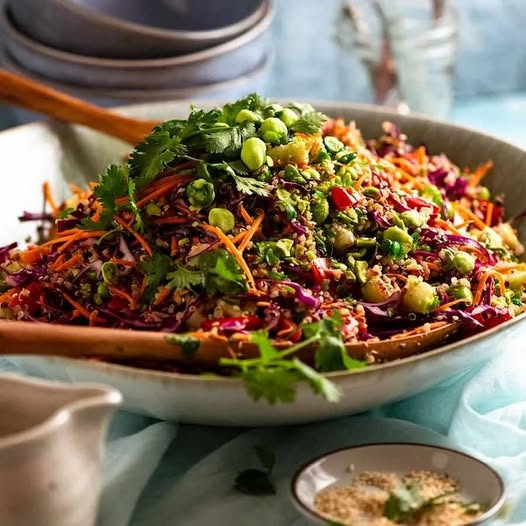
My Favourite Quinoa Salad
Instructions
Cook quinoa:
-
Toast for extra flavour: Preheat oven to 200°C/390°F (180° fan) Spread quinoa on a tray. Bake 15 minutes, stirring halfway, until it’s lightly browned and smells nutty.
-
Rinse: Transfer to fine mesh sieve or strainer. Rinse under running water for 10 seconds, shake off excess water well.
-
Cook: Scrape into a medium saucepan. Add water, place lid on. Bring to simmer on medium heat, then lower stove to low and simmer for 15 minutes (or until all water is absorbed, tilt pot to check).
-
Rest: Remove from stove (lid still on) and rest for 10 minutes.
-
Fluff & cool: Remove lid, fluff quinoa with a fork and allow to fully cool before using. (Spread on a tray if you want to speed things up).
Salad:
-
Dressing: Place ingredients in a jar and shake well.
-
Toss salad! Place quinoa in a large bowl. Add all salad ingredients. Pour over dressing, toss very well.
-
Garnish: Either transfer to a large serving platter or individual bowls. Sprinkle generously with crushed Wasabi Peas and sesame seeds. Devour!
Recipe Notes:
2. Cucumber – If using Lebanese (shorter) cucumbers, there’s no need to peel them but scrape out the watery seeds using a teaspoon (cut in half lengthwise then scrape out). If using the longer ones (English/Telegraph), use around 20cm/8″ and peel the skin (it tends to be a bit tougher) but no need to remove seeds (it’s not as watery).
3. Carrot shredding – I use a shredder tool that creates really thin strands, it cost a pittance from an Asian store. The finer the strands, the better. Fallback: Standard box grater.
4. Edamame – The fresh beans of young soybeans, easily found these days in the freezer section of everyday grocery stores alongside peas! Cook time is the same for with-pod vs podded, around 5 minutes.
5. Soy sauce – Use light or all-purpose soy sauce. Do not use dark soy sauce (too strong) or sweet soy sauce (too sweet).
6. Mirin – A sweet Japanese cooking wine, it adds depth of flavour and complexity to anything. Substitute 1/2 tsp sugar + 1 tbsp extra rice wine + 1/2 tbsp extra mayonnaise.
7. Sesame oil – Use toasted, which has a more intense sesame flavour (it’s brown in colour). Untoasted oil is yellow and harder to find in Australia.
8. Kewpie mayonnaise – A popular Japanese mayonnaise easily found these days in the Asian section of grocery stores. Famed for the smooth flavour and gentle rice vinegar tang! Sub with any mayo.
Substitute: More oil (same amount as mayo).
9. Wasabi peas – Common these days, find them in the Asian section of any grocery store. Crush so some of it becomes a powder using whatever method works for you, eg. mortar and pestle, or tea towel and meat mallet or rolling pin.
10. Sesame seeds – Toast, stirring regularly, in a small skillet (no oil) until lightly browned and they smell nutty!
11. Storage/make ahead – Being cabbage-based, this salad keeps pretty well the next day! It wilts a bit and becomes a little slaw-like. Toss well and consume at room temperature. If intentionally making ahead, best to keep dressing and garnishes separate.
11. Nutrition per serving, assuming 10 servings as a side dish.
